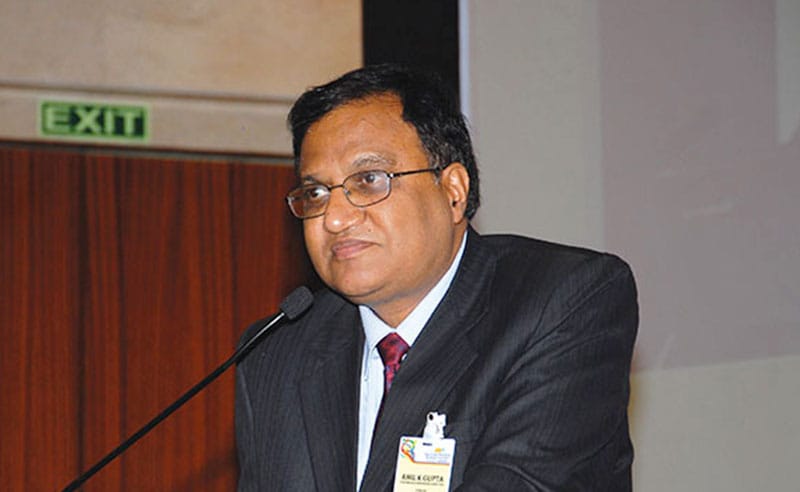[vc_row][vc_column][vc_column_text css=”.vc_custom_1476364899947{margin-top: -20px !important;}”]Anil Kumar Gupta, CMD, Concor[/vc_column_text][vc_column_text]
The slowdown in global trade and slump in Chinese economy had far reaching impact, of which, even Concor has got its share, but the logistics giant is pinning hopes on the DFCs and the industrial clusters that will mushroom along
How has been 2015-16 for Concor?
There was a decline of 11 per cent in the profit. Main drop is in domestic business (14 per cent) compared to last year, while international business declined by 8 per cent. Decline is in both exports and imports. There were linking problems in pipavav for a month, in mundra there was traffic disruption for almost three weeks, in JN Port there was strike in the third terminal – these were the reasons for decline in business in the first half. But in the second half it is the pure business which led to the drop. However, turnover wise we have grown around 11 per cent.
What would be the reasons for the import drops?
Even in the festival times imports were very less. There was a big drop in import from China and Far East. Export from China has drastically come down, which impacted our imports as well.
What about your expansion plans?
We have further extended our plans beyond 2018 as against the earlier plan and we have added fifteen more plans. Land acquisition for various projects is on. Our plans are in tune with the growth of Dedicated Freight Corridors (DFC). For example as of now it would take 48 hours for one train from Mumbai to Delhi with 90 containers and when DFCs comes in place the train size will increase, a train can carry 400 boxes and it can cover the same distance within 16 to 20 hours. Environmental aspects are going to be a big matter of concern where Concor has a major role to play. Nestle gets certificates from Concor when they move cargo and they are getting carbon credits somewhere.
As oil prices decline road logistics benefit, how will rail logistics get its share?
Railway has to find a way of diffusing its costs. Railways’ main problem is staff cost. The new pay commission will have an impact of `32,000 crore on railway which is almost one third of their expense. Now the Rail Regulatory Authority is going to come and we are hopeful that some ways are being suggested by them in order to balance Railways expenses.
What are the major cargo origin and destination points for you?
Western Freight Corridor, starting from JN Port ending at Dadri and Estern Freight Corridor, starting from Kolkata, comes to Dadri where both the corridors combine and goes to Ludhiyana. And subsequently, 150 kilometers of industrial corridors on either side of Western Freight Corridor and 100 kilometers of industrial corridors on either side of the Easter Freight Corridors are crucial for us. Industrial clusters are coming up here and drive future growth of the country. DFCs will not have terminals where we would put up MMLPs which would handle both container and bulk cargo.
Will Concor make use of growing coastal movement of cargo?
We have already started doing some coastal shipping, using services like Shreyas. From North India a lot of cargo used to go to Cochin earlier but now we are moving it to Mundra and from there it goes to Cochin via coastal movement and in return they are being booked for moving empties to Gandhidham and from there we are taking cargo. We are also trying to get cargo via coastal movement from Cochin, like Coir, Rubber etc.
Why container movement hasn’t picked up in east coast?
The main reason is most of our import comes from Far East but we are not exporting anything there. Many ports have come up recently, but for a customer it is the total cost and time that matters. If the overall cost of logistics from east coast is not going to reduce why would a customer want to sell his products? We have been trying it with east coast but there has only been imports no exports which is creating an imbalance. I hope, over time our exports to Far East improve then this problem will be resolved. Even today shipping cost from Mumbai to Singapore is less than that of Vizag to Singapore.
Anywhere do the waterways have any last mile connectivity? How do you look at them?
We have heard some discussion in the ministry of shipping, they are making one terminal in Varanasi and we have told them we are open to any sort of venture if we find our prospective emerging there. My only apprehension is that, in IWT mode whether it will be economical for people to make a stronger jetty? It would cost around `40-50 crores to construct a jetty and with barges carrying very minimum number of boxes, whether it will be cost effective is my apprehension.
[/vc_column_text][/vc_column][/vc_row]




